Ile Royale, French Guiana: Following two days sailing from Parintins, Brazil, we arrived at the Iles du Salut, Salvation Islands, a cluster of small  islands approximately seven miles off the coast of French Guiana. There are three islands in the group: Ile du Diable, Devil’s Island; Ile Royale, Royale Island; and Ile Saint Joseph, Saint Joseph Island.
islands approximately seven miles off the coast of French Guiana. There are three islands in the group: Ile du Diable, Devil’s Island; Ile Royale, Royale Island; and Ile Saint Joseph, Saint Joseph Island.
For 100 years, these three islands formed the infamous penal colony of Cayenne, commonly known as Devil’s Island. Reserved for the worst criminals of France, it was notorious both for the staff’s harsh treatment of detainees and the tropical climate and diseases that contributed to high mortality. The prison system had a death rate of 75 percent until it was finally closed in 1953 (Pictured: Ile du Diable).
 Ile Royale was the reception center for the general prisoner population. Ile Saint Joseph was the reclusion, where inmates were sent to be punished by solitary confinement. Ile du Diable, Devil’s Island, was reserved for the exile of French political prisoners.
Ile Royale was the reception center for the general prisoner population. Ile Saint Joseph was the reclusion, where inmates were sent to be punished by solitary confinement. Ile du Diable, Devil’s Island, was reserved for the exile of French political prisoners.
The horrors of the penal settlement were publicized during the Dreyfus affair, when French army captain Alfred Dreyfus was unjustly convicted of treason and sent to Devil’s Island on January 5 1895. In 1938, abuses were  once again laid bare by the penal system’s most famous escapee, René Belbenoît, in his shocking memoir The Dry Guillotine: Fifteen Years Among the Living Dead. And in 1969, Devil’s Island once again came to our attention with Henri Charrière’s bestselling book, Papillon, later to be made into an extremely popular film with Steve McQueen and Dustin Hoffman.
once again laid bare by the penal system’s most famous escapee, René Belbenoît, in his shocking memoir The Dry Guillotine: Fifteen Years Among the Living Dead. And in 1969, Devil’s Island once again came to our attention with Henri Charrière’s bestselling book, Papillon, later to be made into an extremely popular film with Steve McQueen and Dustin Hoffman.
Devil’s Island itself is, of course, no longer accessible to the public. There are simply no docking facilities; and the cable car system that provided access has long since ceased to function. The closest you can get is an off shore view from a charter boat. Most cruise passengers are transported via ship’s tender – as we were – to Ile Royale. Pathways allow visitors to circle the island and to wander among the ruins of prison cells and administrative buildings.
As noted above, Ile Royale housed the colony’s administrative center and the wardens’ accommodations. The complex was virtually a self-contained  community with houses, offices, a hospital, bakery, butcher shop, and church. A restoration program has been quite successful in recovering some of the buildings, one of which now houses a small museum. There is also a hotel, the Auberge Iles du Salut, which provides modest tourist facilities (Pictured Above: Church, Hospital, Prison Courtyard).
community with houses, offices, a hospital, bakery, butcher shop, and church. A restoration program has been quite successful in recovering some of the buildings, one of which now houses a small museum. There is also a hotel, the Auberge Iles du Salut, which provides modest tourist facilities (Pictured Above: Church, Hospital, Prison Courtyard).
NOTE: If you would like to know more about the Dreyfus affair mentioned above, I would highly recommend An Officer and a Spy by Robert Harris. A brilliant work of historical fiction.
Bridgetown, Barbados: An island country in the western area of the North Atlantic, Barbados is located 62  miles east of the Windward Islands and the Caribbean Sea, and approximately 104 miles east of the islands of Saint Vincent and the Grenadine (our next port of call). The island has an area of about 267 miles. It’s capital and largest city is Bridgetown; its official language is English. As of 2008, Barbados had a population of 284,000 people; approximately 80,000 live in and around Bridgetown.
miles east of the Windward Islands and the Caribbean Sea, and approximately 104 miles east of the islands of Saint Vincent and the Grenadine (our next port of call). The island has an area of about 267 miles. It’s capital and largest city is Bridgetown; its official language is English. As of 2008, Barbados had a population of 284,000 people; approximately 80,000 live in and around Bridgetown.
The earliest inhabitants of the island were Native Americans. Barbados was first visited by the Spanish in the  late 1400s to early 1500s. It first was on a Spanish map in 1511. The native Arawaks (a peaceful farming tribe that dates back to prehistoric times. They lived throughout the Caribbean and in parts of South America) may have fled or been enslaved. The Portuguese visited in 1536. The first English ship, the Olive Blossom, arrived in 1624, claiming that the island belonged to the British king James I. Two years later the first permanent settlers arrived from England. Slaves from Africa were sent to the island to work on the sugar plantations.
late 1400s to early 1500s. It first was on a Spanish map in 1511. The native Arawaks (a peaceful farming tribe that dates back to prehistoric times. They lived throughout the Caribbean and in parts of South America) may have fled or been enslaved. The Portuguese visited in 1536. The first English ship, the Olive Blossom, arrived in 1624, claiming that the island belonged to the British king James I. Two years later the first permanent settlers arrived from England. Slaves from Africa were sent to the island to work on the sugar plantations.
Barbados has been an independent country since November of 1966. Elizabeth II, Queen of Barbados was the  head of state. The Queen was represented locally by the Governor-General. The Prime Minister was the local head of the government. On November 30, 2021, the monarchy and the office of governor-general were abolished and the country became a republic with the President of Barbados becoming the head of state.
head of state. The Queen was represented locally by the Governor-General. The Prime Minister was the local head of the government. On November 30, 2021, the monarchy and the office of governor-general were abolished and the country became a republic with the President of Barbados becoming the head of state.
Since we only had one day in Barbados, we decided on an excursion that would acquaint us with the highlights  of the island. Our first stop was Gun Hill Signal Station. Located in the parish of St. George, its history dates back to 1697 when it was named as one of the four points where guns could be placed in the event of an invasion. In 1818, it became part of a series of signal stations that sighted ships approaching Barbados and signaled to each other, advising as to the type of vessel and whether it could be friend or foe. A chart in the signal tower clearly demonstrated how detailed information could be relayed with the use of several flags. These signal stations were also used to warn of slave rebellions on the island.
of the island. Our first stop was Gun Hill Signal Station. Located in the parish of St. George, its history dates back to 1697 when it was named as one of the four points where guns could be placed in the event of an invasion. In 1818, it became part of a series of signal stations that sighted ships approaching Barbados and signaled to each other, advising as to the type of vessel and whether it could be friend or foe. A chart in the signal tower clearly demonstrated how detailed information could be relayed with the use of several flags. These signal stations were also used to warn of slave rebellions on the island.
 After the decline of the signal stations, the Gun Hill buildings fell into disrepair. These included the station with its prominent tower, a kitchen, magazine, sentry box and ruined barracks. Fortunately, in 1981, the Barbados National Trust leased the station from the government and, with the help of a government grant, restored it to its former glory. The facility now houses a collection of military memorabilia and a small restaurant.
After the decline of the signal stations, the Gun Hill buildings fell into disrepair. These included the station with its prominent tower, a kitchen, magazine, sentry box and ruined barracks. Fortunately, in 1981, the Barbados National Trust leased the station from the government and, with the help of a government grant, restored it to its former glory. The facility now houses a collection of military memorabilia and a small restaurant.
 With its beautiful landscaped gardens and magnificent & captivating views of the island, Gun Hill has become not only an important tourist attraction, but also a venue for weddings and other important social events. An added attraction is the magnificent lion statue, carved out of a single piece of rock in 1868, by an office at the signal station.
With its beautiful landscaped gardens and magnificent & captivating views of the island, Gun Hill has become not only an important tourist attraction, but also a venue for weddings and other important social events. An added attraction is the magnificent lion statue, carved out of a single piece of rock in 1868, by an office at the signal station.
Our next stop was a brief “photo opp” at the beach. Yes, Barbados has many beautiful beaches, but  Bathsheba Beach is quite unique. Situated on the island’s east coast, its picturesque setting is, indeed, a rustic & rocky photographer’s paradise… My photo doesn’t quite do justice to the beach’s dramatic rock formations, but I just couldn’t resist this incredibly great shot.
Bathsheba Beach is quite unique. Situated on the island’s east coast, its picturesque setting is, indeed, a rustic & rocky photographer’s paradise… My photo doesn’t quite do justice to the beach’s dramatic rock formations, but I just couldn’t resist this incredibly great shot.
… And for surfer’s, there’s Bathsheba’s famous Soup Bowl. Named after the area’s foamy water, the Soup Bowl is well-known as a site for international surfing competitions… But don’t even think about swimming here. Because of the rough waters & rock formations… and the extremely strong undercurrents, it simply is not safe. Fly a kite, enjoy a beach picnic, and take a few photographs… but, whatever you do, stay out of the water.
Located in the village of Bathsheba in the parish of Saint Joseph, Andromeda Botanic Gardens is an eight-acre  organic botanical garden created by horticulturalist Iris Bannochie, a native Barbadian and self-taught scientist. Named for the Greek mythological figure of Andromeda, it has been described by a Royal Horticultural Society judge as “one of the most unique and outstanding gardens in the world.” Comprised of twenty connected gardens, the variety of plants is extraordinary. There are over five hundred plant species, including over one hundred species of trees.
organic botanical garden created by horticulturalist Iris Bannochie, a native Barbadian and self-taught scientist. Named for the Greek mythological figure of Andromeda, it has been described by a Royal Horticultural Society judge as “one of the most unique and outstanding gardens in the world.” Comprised of twenty connected gardens, the variety of plants is extraordinary. There are over five hundred plant species, including over one hundred species of trees.
Andromeda Botanic Gardens was first opened to the public during a fund-raising event hosted by the  Barbados Horticultural Society in the 1970s. It has remained open by paid admission since that time (admission is free for residents of Barbados). Bequeathed to the Barbados National Trust upon the death of Ms. Bannochie in 1988, it is currently leased to Passiflora Ltd. The company is responsible for the garden’s management and development and is a registered training provider and assessment center, offering a range of horticultural courses. The new Ethnobotanical Garden is the centerpiece of Andromeda’s mandate to conserve local flora. Created in June 2022 on 2 acres of land at Andromeda, the new garden is a community space and a celebration of local plants, how people in Barbados use plants (contemporary & historical), and local wildlife.
Barbados Horticultural Society in the 1970s. It has remained open by paid admission since that time (admission is free for residents of Barbados). Bequeathed to the Barbados National Trust upon the death of Ms. Bannochie in 1988, it is currently leased to Passiflora Ltd. The company is responsible for the garden’s management and development and is a registered training provider and assessment center, offering a range of horticultural courses. The new Ethnobotanical Garden is the centerpiece of Andromeda’s mandate to conserve local flora. Created in June 2022 on 2 acres of land at Andromeda, the new garden is a community space and a celebration of local plants, how people in Barbados use plants (contemporary & historical), and local wildlife.
One additional note… After expending a significant amount of time & energy becoming acquainted with the local  flora and fauna, I would be very much amiss if I failed to suggest that, at this point, a bit of restorative refreshment might be very much in order. So, permit me to suggest the Eastside Kitchen Café as the perfect spot to seek out a suitable restorative. For while independently owned, it also happens to be conveniently located on the grounds of Andromeda Botanic Gardens. The
flora and fauna, I would be very much amiss if I failed to suggest that, at this point, a bit of restorative refreshment might be very much in order. So, permit me to suggest the Eastside Kitchen Café as the perfect spot to seek out a suitable restorative. For while independently owned, it also happens to be conveniently located on the grounds of Andromeda Botanic Gardens. The  Eastside offers up numerous forms of pleasurable liquid libations – Whisky Sour, G&T, Real Fruit Daiquiri, Pina Colada, Margarita, Mint Mojito, Beer, Wine; as well as a host of natural juices and other nonalcoholic beverages – “when in Rome,” as they say… In Barbados, rum is clearly the name of the game. Go with either the Rum Punch or Rum Sour and you won’t be disappointed.
Eastside offers up numerous forms of pleasurable liquid libations – Whisky Sour, G&T, Real Fruit Daiquiri, Pina Colada, Margarita, Mint Mojito, Beer, Wine; as well as a host of natural juices and other nonalcoholic beverages – “when in Rome,” as they say… In Barbados, rum is clearly the name of the game. Go with either the Rum Punch or Rum Sour and you won’t be disappointed.
And the food is quite good as well. Perched on Andromeda’s open porch, it may not look like much, but Chef  Dwayne and his wife, Joanne, do a marvelous job of preparing a host of local ingredients – such as fish, octopus, chicken, and vegetables – with a loving care that belies their simple surroundings. You may begin, for example, with the Homemade Hummus and move on to such entrées as Whole Local Lobster, Fried or Grilled Octopus, Shrimp Linguine, and a perfectly seasoned Barracuda Sandwich.
Dwayne and his wife, Joanne, do a marvelous job of preparing a host of local ingredients – such as fish, octopus, chicken, and vegetables – with a loving care that belies their simple surroundings. You may begin, for example, with the Homemade Hummus and move on to such entrées as Whole Local Lobster, Fried or Grilled Octopus, Shrimp Linguine, and a perfectly seasoned Barracuda Sandwich.
Reviews of Eastside Kitchen Café on social media have been overwhelmingly positive. Another plus is that you may access the restaurant without actually visiting Andromeda Gardens, although I would strongly encourage you to do so.
Bon Appétit & Cheers!
TAD
{ 0 comments }
 developed (and later sold) iconic brands such has House Wine and Charles Smith Wines, producing such smash hits as Kung Fu Girl Riesling, Boom Boom Syrah, and Velvet Devil Merlot. His recognition awards speak for themselves: Wine & Spirits Winery of the Year, 2008; Food & Wine Winemaker of the Year, 2009; Wine Enthusiast Winemaker of the Year, 2014; placed #2 and #13 on the Wine Spectator Top 100 List, 2017. In 2006, he created Royal City Syrah, a cult-favorite, that made him one of only four Washington winemakers to ear a 100-point score. His current enterprise, House of Smith in Seattle, Washington, is the largest urban winery on the West Coast and includes such brands as K Vintners, Substance, ViNO, CasaSmith, SIXTO, B.Leighton, and Golden West.
developed (and later sold) iconic brands such has House Wine and Charles Smith Wines, producing such smash hits as Kung Fu Girl Riesling, Boom Boom Syrah, and Velvet Devil Merlot. His recognition awards speak for themselves: Wine & Spirits Winery of the Year, 2008; Food & Wine Winemaker of the Year, 2009; Wine Enthusiast Winemaker of the Year, 2014; placed #2 and #13 on the Wine Spectator Top 100 List, 2017. In 2006, he created Royal City Syrah, a cult-favorite, that made him one of only four Washington winemakers to ear a 100-point score. His current enterprise, House of Smith in Seattle, Washington, is the largest urban winery on the West Coast and includes such brands as K Vintners, Substance, ViNO, CasaSmith, SIXTO, B.Leighton, and Golden West. story of musician Sixto Rodriguez, the Detroit musician whose late-career resurgence is depicted in the Oscar-winning documentary “Searching for Sugar Man,” SIXTO became the resurgence chardonnay project of winemaker Charles Smith and VP of Winemaking & Viticulture Brennon Leighton, who released their first vintage in 2014. The brand consists of four distinguished wines: three single vineyards (Frenchman Hills, Moxee, and Roza Hills Chardonnay) and one cuvée of all three vineyards (Uncovered Chardonnay).
story of musician Sixto Rodriguez, the Detroit musician whose late-career resurgence is depicted in the Oscar-winning documentary “Searching for Sugar Man,” SIXTO became the resurgence chardonnay project of winemaker Charles Smith and VP of Winemaking & Viticulture Brennon Leighton, who released their first vintage in 2014. The brand consists of four distinguished wines: three single vineyards (Frenchman Hills, Moxee, and Roza Hills Chardonnay) and one cuvée of all three vineyards (Uncovered Chardonnay). Located 90 miles east of San Francisco, sandwiched between Sacramento in the north and Stockton in the south, Lodi was once known for supplying low-cost grapes that eventually found their way into North Coast chardonnays, cabernets, zinfandels, and viogniers.
Located 90 miles east of San Francisco, sandwiched between Sacramento in the north and Stockton in the south, Lodi was once known for supplying low-cost grapes that eventually found their way into North Coast chardonnays, cabernets, zinfandels, and viogniers. wineries are located in Nap, Lodi (4), and the Sierra Foothills of Amador County, each with their own grape sources and winemakers. Their brands have earned more than seventy Best Buy/Best of Class/90+Point ratings in the past several years.
wineries are located in Nap, Lodi (4), and the Sierra Foothills of Amador County, each with their own grape sources and winemakers. Their brands have earned more than seventy Best Buy/Best of Class/90+Point ratings in the past several years. city is recognized locally and internationally for the quality of its cuisine, music, and architecture. Brazil is the most African of all South American countries; and this is clearly observed in many of the Salvador’s cultural aspects. As the first capital of Colonial Brazil, the city is one of the oldest in the Americas. Its foundation in 1549 took place as a result of the implementation of the General Government of Brazil by the Portuguese Empire. The historic center of Salvador is known for its colonial architecture, with historical monuments dating from the 17th century to the beginning of the 20th century; and it was declared a World Heritage Site by UNESCO in 1985 (Pictured: Church of Our Lord of Bonfim, the most famous of the Catholic churches of Salvador, built in the 18th century).
city is recognized locally and internationally for the quality of its cuisine, music, and architecture. Brazil is the most African of all South American countries; and this is clearly observed in many of the Salvador’s cultural aspects. As the first capital of Colonial Brazil, the city is one of the oldest in the Americas. Its foundation in 1549 took place as a result of the implementation of the General Government of Brazil by the Portuguese Empire. The historic center of Salvador is known for its colonial architecture, with historical monuments dating from the 17th century to the beginning of the 20th century; and it was declared a World Heritage Site by UNESCO in 1985 (Pictured: Church of Our Lord of Bonfim, the most famous of the Catholic churches of Salvador, built in the 18th century). notable exception was a lake containing floats that symbolized Orixás, spirits or ancestors that have been deified in the Umbanda and Candomblé religions (pictured). Both religions exist only in Brazil, but they have their foundation in different African religions and beliefs. They were created by Africans who were enslaved and forced to come to Brazil.
notable exception was a lake containing floats that symbolized Orixás, spirits or ancestors that have been deified in the Umbanda and Candomblé religions (pictured). Both religions exist only in Brazil, but they have their foundation in different African religions and beliefs. They were created by Africans who were enslaved and forced to come to Brazil. tables and sunshades. Famous for its utilization of fresh local fruit in all its homemade ice creams, sorbets, and juices, it has become an “absolute must” destination for locals and tourists alike. Frenchman Georges Laporte is the artisan behind the classy ice cream emporium and may often be seen scooping away behind the counter, offering sage advice on choosing between the many delicious flavors he has to offer. I just know that my traveling companion’s Strawberry Sorbet and my Caraíba Ice Cream (acerola cherry, ginger and lime) were the best we have sampled anywhere in the world. By the way, Le Glacier Laporte has received excellent reviews in both Yelp and Triadvisor and is mentioned prominently in the New York Times article “36 Hours in Salvador, Brazil” noted above.
tables and sunshades. Famous for its utilization of fresh local fruit in all its homemade ice creams, sorbets, and juices, it has become an “absolute must” destination for locals and tourists alike. Frenchman Georges Laporte is the artisan behind the classy ice cream emporium and may often be seen scooping away behind the counter, offering sage advice on choosing between the many delicious flavors he has to offer. I just know that my traveling companion’s Strawberry Sorbet and my Caraíba Ice Cream (acerola cherry, ginger and lime) were the best we have sampled anywhere in the world. By the way, Le Glacier Laporte has received excellent reviews in both Yelp and Triadvisor and is mentioned prominently in the New York Times article “36 Hours in Salvador, Brazil” noted above. “Fortress”) is the capital of the northeastern Brazilian state of Ceará. It is Brazil’s fourth largest city, having surpassed Salvador in the 2023 census, with a population of slightly over 2.7 million. It is also the core of the Fortaleza metropolitan area, which is home to slightly over 4.1 million people. Fortaleza is an important industrial and commercial center. And, according to the Ministry of Tourism, it is the fourth most visited city and tourist destination in the country.
“Fortress”) is the capital of the northeastern Brazilian state of Ceará. It is Brazil’s fourth largest city, having surpassed Salvador in the 2023 census, with a population of slightly over 2.7 million. It is also the core of the Fortaleza metropolitan area, which is home to slightly over 4.1 million people. Fortaleza is an important industrial and commercial center. And, according to the Ministry of Tourism, it is the fourth most visited city and tourist destination in the country. Brazilian religions, Spiritualism, Judaism, Hinduism, Buddhism, Island, other Eastern religions, Esotericism and other Christian churches such as the Church of Jesus Christ of Latter-Day Saints had a smaller number of adherents.
Brazilian religions, Spiritualism, Judaism, Hinduism, Buddhism, Island, other Eastern religions, Esotericism and other Christian churches such as the Church of Jesus Christ of Latter-Day Saints had a smaller number of adherents. by various economic activities, including rubber extraction (during last century), coffee production, and gold mining. Most recently, there has been significant growth in soybean plantations.
by various economic activities, including rubber extraction (during last century), coffee production, and gold mining. Most recently, there has been significant growth in soybean plantations. – the intriguing confluence of the waters of Amazon River and one of its tributaries – (more on that when we reach Manaus). We then continued our journey through the muddy waters… taking in the primeval flora & fauna… the exotic birds… a variety of lizards… an occasional pink dolphin… a lazy tree sloth…and the rundown shacks along the shoreline…
– the intriguing confluence of the waters of Amazon River and one of its tributaries – (more on that when we reach Manaus). We then continued our journey through the muddy waters… taking in the primeval flora & fauna… the exotic birds… a variety of lizards… an occasional pink dolphin… a lazy tree sloth…and the rundown shacks along the shoreline… Manaus is the capital and largest city (2,219,580 pop.) of the Brazilian state of Amazonas. It is also home to the National Institute of Amazonian Research, the most important center for scientific studies in the Amazon region. It has a free port and an international airport. It manufactures electronics, chemical products and soap, and exports Brazil nuts, rubber, jute, and rosewood oil. The city boasts a cathedral, opera house, zoological and botanical gardens, an eco-park, and regional and native people’s museums (Pictured: Manaus skyline with prominent dome of the Opera House).
Manaus is the capital and largest city (2,219,580 pop.) of the Brazilian state of Amazonas. It is also home to the National Institute of Amazonian Research, the most important center for scientific studies in the Amazon region. It has a free port and an international airport. It manufactures electronics, chemical products and soap, and exports Brazil nuts, rubber, jute, and rosewood oil. The city boasts a cathedral, opera house, zoological and botanical gardens, an eco-park, and regional and native people’s museums (Pictured: Manaus skyline with prominent dome of the Opera House). according to David Grann in his book The Lost City of Z, it was “one of the gaudiest cities in the world.” As historian Robin Furneaux noted: “No extravagance however absurd, deterred” the rubber barons. However, when the seeds of the rubber tree were smuggled out of the Amazon region to be cultivated on plantations in Southeast Asia, Brazil and Peru lost their monopoly on the product. The rubber boom ended abruptly, many people left its major cities, and Manaus fell into poverty (Pictured: St. Sebastian Square).
according to David Grann in his book The Lost City of Z, it was “one of the gaudiest cities in the world.” As historian Robin Furneaux noted: “No extravagance however absurd, deterred” the rubber barons. However, when the seeds of the rubber tree were smuggled out of the Amazon region to be cultivated on plantations in Southeast Asia, Brazil and Peru lost their monopoly on the product. The rubber boom ended abruptly, many people left its major cities, and Manaus fell into poverty (Pictured: St. Sebastian Square). me, if you’ve seen one market, you’ve pretty much seen them all. If I never set eyes on another public market, it will be far too soon. This was followed by a drive-by (since we were not allowed inside) of the Palácio Rio Negro (pictured), the former seat of government, now residence of governor of Amazonas. The stately mansion was originally built at the behest of German entrepreneur Karl Waldemar Scholz, one of the so-called “rubber barons.”
me, if you’ve seen one market, you’ve pretty much seen them all. If I never set eyes on another public market, it will be far too soon. This was followed by a drive-by (since we were not allowed inside) of the Palácio Rio Negro (pictured), the former seat of government, now residence of governor of Amazonas. The stately mansion was originally built at the behest of German entrepreneur Karl Waldemar Scholz, one of the so-called “rubber barons.” of yellow fever. The opera house was closed for most of the 20th century. However, it was used in scenes of the Werner Herzog film Fitzcarraldo (1982). After a hiatus of almost 90 years, it reopened to produce live opera in 1997 and is now attracting performers from all over the world.
of yellow fever. The opera house was closed for most of the 20th century. However, it was used in scenes of the Werner Herzog film Fitzcarraldo (1982). After a hiatus of almost 90 years, it reopened to produce live opera in 1997 and is now attracting performers from all over the world. Meeting of Waters. This is the confluence of the dark water of the Rio Negro and the light sandy water of the Amazon, referred to as the Solimöes River in Brazil upriver of the confluence. For approximately 3.7 miles the waters of the two rivers run side by wide without mixing. This phenomenon is due to the differences in temperature, speed, and number of dissolved sediments in the waters of the two rivers. The Rio Negro flows at 1.2 mph at a temperature 82 degrees, while the Rio Solimöes flows between 2.5 – 3.7 mph at a temperature of 72 degrees. The light-colored water is rich with sediment from the Andes Mountains, whereas the black water, running from the Colombian hills and interior jungles is nearly sediment-free and colored by decayed leaf and plant matter. Smaller -scale meeting of waters of the Amazon also occurs in Santarém, Brazil (noted above) and Iquitos, Peru.
Meeting of Waters. This is the confluence of the dark water of the Rio Negro and the light sandy water of the Amazon, referred to as the Solimöes River in Brazil upriver of the confluence. For approximately 3.7 miles the waters of the two rivers run side by wide without mixing. This phenomenon is due to the differences in temperature, speed, and number of dissolved sediments in the waters of the two rivers. The Rio Negro flows at 1.2 mph at a temperature 82 degrees, while the Rio Solimöes flows between 2.5 – 3.7 mph at a temperature of 72 degrees. The light-colored water is rich with sediment from the Andes Mountains, whereas the black water, running from the Colombian hills and interior jungles is nearly sediment-free and colored by decayed leaf and plant matter. Smaller -scale meeting of waters of the Amazon also occurs in Santarém, Brazil (noted above) and Iquitos, Peru. caiman, perhaps, or a giant otter; but neither, apparently, felt up to putting in a guest appearance. In their absence, the Victoria Amazonica, giant water lilies (pictured), stirred up the most interest. The largest member of the water lily family (Nymphaeacae), they are, indeed, the most striking of all the Amazon’s aquatic plants.
caiman, perhaps, or a giant otter; but neither, apparently, felt up to putting in a guest appearance. In their absence, the Victoria Amazonica, giant water lilies (pictured), stirred up the most interest. The largest member of the water lily family (Nymphaeacae), they are, indeed, the most striking of all the Amazon’s aquatic plants. of the largest annual festivals in Brazil, as only the Carnival in Rio de Janeiro and Salvador draw more participants.
of the largest annual festivals in Brazil, as only the Carnival in Rio de Janeiro and Salvador draw more participants. have a special abbreviated version of the festival performed just for the passengers of our cruise ship. It was, in a word, spectacular!
have a special abbreviated version of the festival performed just for the passengers of our cruise ship. It was, in a word, spectacular! Taking place over the week prior to the beginning of Lent, the world-famous Carnival features colorful parades, parties, and a host of open-air performances. Each year millions of Brazilians and tourists from around the world observe/participate in this extraordinary happening. The center of attraction is the 90,000 seat Sambadrome, where spectators watch a procession of samba schools parading before judges. Each group passes-by to the sound of distinctive Brazilian samba and drumming, dressed in colorful costumes on immense floats, all based upon different themes (pictured). Each night the spectacle goes on until dawn and into the next morning. In addition to the parades in the Sambadrome, there are many free blocos, which occur throughout the day in the streets of the city. Needless to say, this makes traveling in Rio exceedingly difficult, as one never quite knows where or when one of these impromptu blocos may pop up, bringing vehicular traffic to a screeching halt.
Taking place over the week prior to the beginning of Lent, the world-famous Carnival features colorful parades, parties, and a host of open-air performances. Each year millions of Brazilians and tourists from around the world observe/participate in this extraordinary happening. The center of attraction is the 90,000 seat Sambadrome, where spectators watch a procession of samba schools parading before judges. Each group passes-by to the sound of distinctive Brazilian samba and drumming, dressed in colorful costumes on immense floats, all based upon different themes (pictured). Each night the spectacle goes on until dawn and into the next morning. In addition to the parades in the Sambadrome, there are many free blocos, which occur throughout the day in the streets of the city. Needless to say, this makes traveling in Rio exceedingly difficult, as one never quite knows where or when one of these impromptu blocos may pop up, bringing vehicular traffic to a screeching halt. cruise. The hotel itself was rather generic, but it was located in a quiet, upscale neighborhood a safe distance from the madding crowds, for which we were extremely thankful. In addition, our guides were quite familiar with the exigencies of Carnival, and thus were able to maximize our enjoyment of the sights while minimizing any possible discomfort (pictured: the famous Copacabana Beach).
cruise. The hotel itself was rather generic, but it was located in a quiet, upscale neighborhood a safe distance from the madding crowds, for which we were extremely thankful. In addition, our guides were quite familiar with the exigencies of Carnival, and thus were able to maximize our enjoyment of the sights while minimizing any possible discomfort (pictured: the famous Copacabana Beach). of Guanabara Bay on a peninsula that juts out into the Atlantic Ocean. Rising 1,299 feet above the harbor, the peak is named for its resemblance to the traditional shape of concentrated refined loaf sugar. The mountain is protected by the Sugarloaf Mountain and Urca Hill Natural Monument, created in 2006. This, in turn, became part of a UNESCO World Heritage Site in 2012. The name Sugarloaf first appeared in the 16th century via the Portuguese, when blocks of sugar were placed in clay conical molds in order to be transported on ships. The form of the mountain peak reminded them of the resulting “sugarloaf” shape; and the nickname has since been extended to be a general descriptor for similar rock formations.
of Guanabara Bay on a peninsula that juts out into the Atlantic Ocean. Rising 1,299 feet above the harbor, the peak is named for its resemblance to the traditional shape of concentrated refined loaf sugar. The mountain is protected by the Sugarloaf Mountain and Urca Hill Natural Monument, created in 2006. This, in turn, became part of a UNESCO World Heritage Site in 2012. The name Sugarloaf first appeared in the 16th century via the Portuguese, when blocks of sugar were placed in clay conical molds in order to be transported on ships. The form of the mountain peak reminded them of the resulting “sugarloaf” shape; and the nickname has since been extended to be a general descriptor for similar rock formations. cars were coated wood and were used for 60 years. In 1972, a second cable was added, as well as new cabins, expanding the capacity from 22 to 75 (eventually reduced to 65 to increase the comfort level).
cars were coated wood and were used for 60 years. In 1972, a second cable was added, as well as new cabins, expanding the capacity from 22 to 75 (eventually reduced to 65 to increase the comfort level). – 98 feet tall, set on a square stone pedestal base 26 feet high, its horizontally outstretched arms spanning 92 feet – has become emblematic of both the city of Rio de Janeiro and the entire nation of Brazil. Constructed of reinforced concrete overlaid with a mosaic of thousands of triangular soapstone tiles, it is also the largest Art Deco-style sculpture in the world.
– 98 feet tall, set on a square stone pedestal base 26 feet high, its horizontally outstretched arms spanning 92 feet – has become emblematic of both the city of Rio de Janeiro and the entire nation of Brazil. Constructed of reinforced concrete overlaid with a mosaic of thousands of triangular soapstone tiles, it is also the largest Art Deco-style sculpture in the world. preparation for the visit of Pope John Paul II; and in 2010, the entire statue was repaired and refurbished. However, if you are contemplating a visit, the most relevant renovation took place in 2002 when escalators and panoramic elevators were added to the facilities. Previously, in order to reach the statue itself, tourists had to climb more than 200 steps as the last stage of their pilgrimage. The escalators (pictured) improved this situation dramatically.
preparation for the visit of Pope John Paul II; and in 2010, the entire statue was repaired and refurbished. However, if you are contemplating a visit, the most relevant renovation took place in 2002 when escalators and panoramic elevators were added to the facilities. Previously, in order to reach the statue itself, tourists had to climb more than 200 steps as the last stage of their pilgrimage. The escalators (pictured) improved this situation dramatically. was almost totally obscured. Which, of course, was a major letdown. However, this photograph should give readers some idea, not only of the utter grandeur of the view, but also of the grandeur & immensity of the statue itself. Regardless of your religious/spiritual preferences, a visit to Rio de Janeiro’s Christ the Redeemer is an incomparably illuminating experience.
was almost totally obscured. Which, of course, was a major letdown. However, this photograph should give readers some idea, not only of the utter grandeur of the view, but also of the grandeur & immensity of the statue itself. Regardless of your religious/spiritual preferences, a visit to Rio de Janeiro’s Christ the Redeemer is an incomparably illuminating experience. grâce – at least literarily speaking – was delivered by Discovery, which included it as one of The World’s 50 Best Restaurants: “Opened in 1996, it’s the magnum opus of chef-owner German chef Harald Bresselschmidt, who cut his teeth at the likes of London’s Savoy. Rooted in classic technique, his menu is a love letter to South Africa’s natural larder. But where things get interesting is how he artfully marries international flavour within such framework. The result is a colourful cuisine – fed by two organic kitchen gardens – running from à la carte and summer small-plate lunches to an ‘East Meets West’ degustation menu.”
grâce – at least literarily speaking – was delivered by Discovery, which included it as one of The World’s 50 Best Restaurants: “Opened in 1996, it’s the magnum opus of chef-owner German chef Harald Bresselschmidt, who cut his teeth at the likes of London’s Savoy. Rooted in classic technique, his menu is a love letter to South Africa’s natural larder. But where things get interesting is how he artfully marries international flavour within such framework. The result is a colourful cuisine – fed by two organic kitchen gardens – running from à la carte and summer small-plate lunches to an ‘East Meets West’ degustation menu.” ordinary, and in the case of my main course, downright awful…. What was awful? My ‘Cape Sea Harvest’ main, featuring monkfish, was a fright. The dish was described as “line fish set on a ragout of broad beans and artichokes with crayfish bisque spinach and grilled octopus”… Monk is rich and sweet… It’s also impressive on the plate with its tail so similar in colour, texture and girth
ordinary, and in the case of my main course, downright awful…. What was awful? My ‘Cape Sea Harvest’ main, featuring monkfish, was a fright. The dish was described as “line fish set on a ragout of broad beans and artichokes with crayfish bisque spinach and grilled octopus”… Monk is rich and sweet… It’s also impressive on the plate with its tail so similar in colour, texture and girth of wilted spinach like a flat hat caught in the rain. The octopus was like takkie rubber; literally unchewable. The monkfish was watery and tasteless. It didn’t even hold together. It wasn’t sweet, it wasn’t rich. The ragout was gloopy, like a confused pasta sauce.”
of wilted spinach like a flat hat caught in the rain. The octopus was like takkie rubber; literally unchewable. The monkfish was watery and tasteless. It didn’t even hold together. It wasn’t sweet, it wasn’t rich. The ragout was gloopy, like a confused pasta sauce.” Then there’s the ambience – or lack thereof. “Zero,” as one reviewer on social media put it. And while I wouldn’t go quite that far, I must admit that the restaurant’s stark interior, which looked infinitely more attractive in photographs than in person, left me rather cold. And, by way of contrast, since weather on the day of our visit was quite warm, the door to the alfresco courtyard remained open, which let in a slight breeze – as well as a host of flies… At times, it seemed we spent more time swatting than eating.
Then there’s the ambience – or lack thereof. “Zero,” as one reviewer on social media put it. And while I wouldn’t go quite that far, I must admit that the restaurant’s stark interior, which looked infinitely more attractive in photographs than in person, left me rather cold. And, by way of contrast, since weather on the day of our visit was quite warm, the door to the alfresco courtyard remained open, which let in a slight breeze – as well as a host of flies… At times, it seemed we spent more time swatting than eating.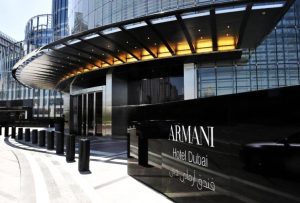 unto itself. A distinctive combination of creative Italian design and signature Arabian hospitality, it simply marches to the beat of a uniquely elegant and sophisticated drummer. Not only does it provide its own grand entrance to the world’s tallest structure, it also favors its guests with private & direct access to the Dubai Mall, the world’s largest and most visited shopping & entertainment destination.
unto itself. A distinctive combination of creative Italian design and signature Arabian hospitality, it simply marches to the beat of a uniquely elegant and sophisticated drummer. Not only does it provide its own grand entrance to the world’s tallest structure, it also favors its guests with private & direct access to the Dubai Mall, the world’s largest and most visited shopping & entertainment destination.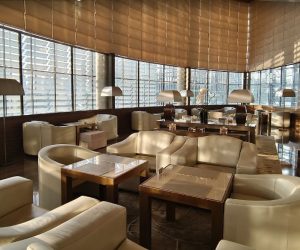 gastronomic possibilities. The Armani Lounge, however, is particularly recommended. Located on the lobby floor of the hotel, this cozy enclave brings a casual yet decidedly cultivated air to all-day dining. The à la carte menu – international fare with Italian flair – is available from 11:00 a.m. to 11:00 p.m. and includes a classy selection of snacks, appetizers, soups, sandwiches, pizza, main courses, and desserts. Snacks, for example, present such diverse epicurean options as Brie Croquette kissed with balsamic dressing; Lobster Arrancini with lemon zest mayo; Tempura Shrimp; Satay, chicken skewers with a peanut dipping sauce; and Loaded Baked Potato with red capsicum, turkey bacon, and cheddar cheese.
gastronomic possibilities. The Armani Lounge, however, is particularly recommended. Located on the lobby floor of the hotel, this cozy enclave brings a casual yet decidedly cultivated air to all-day dining. The à la carte menu – international fare with Italian flair – is available from 11:00 a.m. to 11:00 p.m. and includes a classy selection of snacks, appetizers, soups, sandwiches, pizza, main courses, and desserts. Snacks, for example, present such diverse epicurean options as Brie Croquette kissed with balsamic dressing; Lobster Arrancini with lemon zest mayo; Tempura Shrimp; Satay, chicken skewers with a peanut dipping sauce; and Loaded Baked Potato with red capsicum, turkey bacon, and cheddar cheese.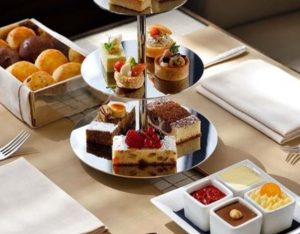 Atlantic Royal Smoked Salmon with lime dill cream fraiche with whole wheat roulade and Venice caviar; Main Lobster Remoulade; Truffle Egg Sandwich on brioche; Mint Cucumber with cream cheese finger on tramezzini bread; and Caprese, mini mozzarella with cherry tomatoes & pesto on English muffin… And then moving on to the likes of Vanilla & Chocolate Marble Cake; Banana Walnut Cake; Traditional English Fruitcake; and a selection of Freshly Baked Scones served with homemade lemon curd, raspberry preserve, and clotted cream… Finally concluding with sweets such as Seasonal Fruit Tartlet with vanilla diplomate (pastry cream); Hazelnut Plaisir with milk chocolate Chantilly; and The Armani: white chocolate cheesecake.
Atlantic Royal Smoked Salmon with lime dill cream fraiche with whole wheat roulade and Venice caviar; Main Lobster Remoulade; Truffle Egg Sandwich on brioche; Mint Cucumber with cream cheese finger on tramezzini bread; and Caprese, mini mozzarella with cherry tomatoes & pesto on English muffin… And then moving on to the likes of Vanilla & Chocolate Marble Cake; Banana Walnut Cake; Traditional English Fruitcake; and a selection of Freshly Baked Scones served with homemade lemon curd, raspberry preserve, and clotted cream… Finally concluding with sweets such as Seasonal Fruit Tartlet with vanilla diplomate (pastry cream); Hazelnut Plaisir with milk chocolate Chantilly; and The Armani: white chocolate cheesecake.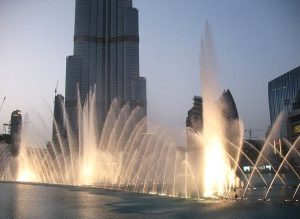 mark; and my Negroni was – absolutely, bar none, without exception – the finest rendition of this cocktail it has ever been my pleasure to ingest.
mark; and my Negroni was – absolutely, bar none, without exception – the finest rendition of this cocktail it has ever been my pleasure to ingest.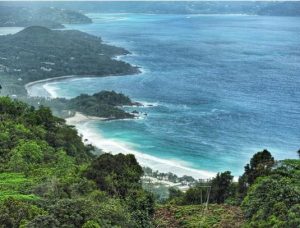 the Seychelles is an archipelago of 115 islands situated in the Indian Ocean just off the coast of east Africa. With a territory of 177 square miles and a population of 92,000 it is the smallest African country. It boasts numerous beautiful beaches, coral reefs, and nature reserves, as well as rare animals. Mahé, is also home to Victoria, the capital (pictured: Mahé Island, sans rain).
the Seychelles is an archipelago of 115 islands situated in the Indian Ocean just off the coast of east Africa. With a territory of 177 square miles and a population of 92,000 it is the smallest African country. It boasts numerous beautiful beaches, coral reefs, and nature reserves, as well as rare animals. Mahé, is also home to Victoria, the capital (pictured: Mahé Island, sans rain).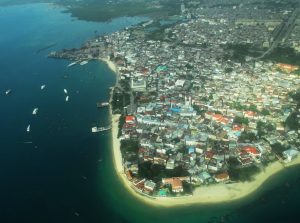 of Zanzibar is supposedly the typical example of a Swahili trading town. Evidently it was the type of community that first developed on the east coast of Africa, expanded under Arab, Indian, and European influences, yet still managed to retain the indigenous elements that were unique to this particular region (pictured: Stone Town aerial view).
of Zanzibar is supposedly the typical example of a Swahili trading town. Evidently it was the type of community that first developed on the east coast of Africa, expanded under Arab, Indian, and European influences, yet still managed to retain the indigenous elements that were unique to this particular region (pictured: Stone Town aerial view).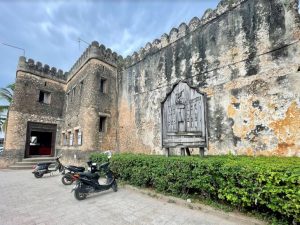 Portuguese in 1699, it was subsequently used as a garrison and prison in the 19th century, and as a terminal of the Zanzibar railways from 1905 – 1928. A new guardhouse was built in 1947 and used as the ladies’ club; and an amphitheater was added in the 1990s. It is now the headquarters of the Zanzibar International Film Festival.
Portuguese in 1699, it was subsequently used as a garrison and prison in the 19th century, and as a terminal of the Zanzibar railways from 1905 – 1928. A new guardhouse was built in 1947 and used as the ladies’ club; and an amphitheater was added in the 1990s. It is now the headquarters of the Zanzibar International Film Festival.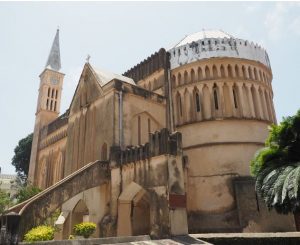 belongs to the Anglican Church of Tanzania and is one of the most prominent examples of early Christian architecture in East Africa. Built in seven years, based upon the vision of Edward Steere, third Anglican bishop of Zanzibar, who actively contributed to its design, it opened its doors on Christmas 1879. Occupying a large space in the center of the old town where the largest slave market had been located, the cathedral was actually constructed to celebrate the end of slavery.
belongs to the Anglican Church of Tanzania and is one of the most prominent examples of early Christian architecture in East Africa. Built in seven years, based upon the vision of Edward Steere, third Anglican bishop of Zanzibar, who actively contributed to its design, it opened its doors on Christmas 1879. Occupying a large space in the center of the old town where the largest slave market had been located, the cathedral was actually constructed to celebrate the end of slavery.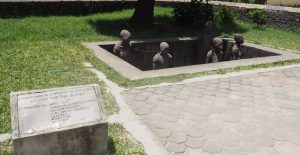 in the adjoining square, there is a monument to the former slaves – several human figures in chains emerging from a pit – as well as a museum on slavery.
in the adjoining square, there is a monument to the former slaves – several human figures in chains emerging from a pit – as well as a museum on slavery.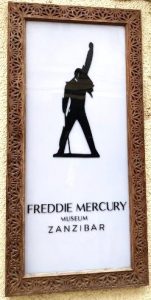 also home to the Freddie Mercury Museum, which pays tribute to its native son and is located in the very house where Mercury and his family resided until they moved to England in 1963. Born Farrokh Bulsara in 1946 to Parsi-Indian parents, he is regarded as one of the greatest singers in the history of rock music, known for his flamboyant stage presence and four-octave vocal range. Having studied and written music for years, he formed Queen in 1970 with guitarist Brian May and drummer Roger Taylor. He wrote numerous hits for Queen, including Killer Queen, Bohemian Rhapsody, Somebody to Love, We Are the Champions Don’t Stop Me Now, and Crazy Little Thing Called Love.
also home to the Freddie Mercury Museum, which pays tribute to its native son and is located in the very house where Mercury and his family resided until they moved to England in 1963. Born Farrokh Bulsara in 1946 to Parsi-Indian parents, he is regarded as one of the greatest singers in the history of rock music, known for his flamboyant stage presence and four-octave vocal range. Having studied and written music for years, he formed Queen in 1970 with guitarist Brian May and drummer Roger Taylor. He wrote numerous hits for Queen, including Killer Queen, Bohemian Rhapsody, Somebody to Love, We Are the Champions Don’t Stop Me Now, and Crazy Little Thing Called Love.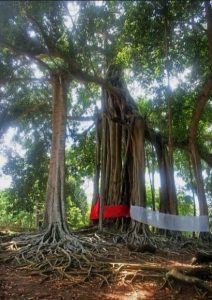 Queen of the Sakalava tribe in 1836 (pictured: the tree we never got to see).
Queen of the Sakalava tribe in 1836 (pictured: the tree we never got to see). based upon my own personal experience, they are not terribly attractive… and then there’s Richards Bay. I won’t bore you with the gory details. Let me simply say that the port here was significantly less than picturesque, as there were two huge mountains of black coal decorating the landscape, A hefty wind had kicked up, so coal dust was everywhere. So much so that those exiting the ship were required to wear face masks. The scene resembled some eerie apocalyptic wasteland.
based upon my own personal experience, they are not terribly attractive… and then there’s Richards Bay. I won’t bore you with the gory details. Let me simply say that the port here was significantly less than picturesque, as there were two huge mountains of black coal decorating the landscape, A hefty wind had kicked up, so coal dust was everywhere. So much so that those exiting the ship were required to wear face masks. The scene resembled some eerie apocalyptic wasteland.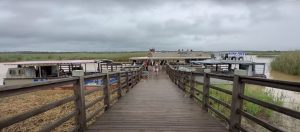 Heritage Site housing hippos and crocodiles – was a little over an hour away and a very pleasant drive through the countryside.
Heritage Site housing hippos and crocodiles – was a little over an hour away and a very pleasant drive through the countryside.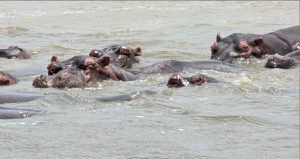 hippopotamus, has kept the name, which is a combination of the Greek words hippos, meaning “horse” and potamos, meaning “river” or “stream.” And “river” is certainly the right name for an animal that spends most of its time in the water and whose eyes, ears, and nostrils are placed so that the it can see, hear, and breathe even if most of its head is underwater (please note photo above).
hippopotamus, has kept the name, which is a combination of the Greek words hippos, meaning “horse” and potamos, meaning “river” or “stream.” And “river” is certainly the right name for an animal that spends most of its time in the water and whose eyes, ears, and nostrils are placed so that the it can see, hear, and breathe even if most of its head is underwater (please note photo above). hour+ drive through the ruggedly beautiful countryside before reaching the Tala Private Game Reserve.
hour+ drive through the ruggedly beautiful countryside before reaching the Tala Private Game Reserve. The wonderful thing about this preserve is that there are no lions or leopards here, so the other animals feel perfectly safe and can roam at will. So much so, that they seem to be totally unafraid of humans. In several instances, the animals were so close to our 4 x 4 that we could practically reach out and pet them. An incredible experience.
The wonderful thing about this preserve is that there are no lions or leopards here, so the other animals feel perfectly safe and can roam at will. So much so, that they seem to be totally unafraid of humans. In several instances, the animals were so close to our 4 x 4 that we could practically reach out and pet them. An incredible experience.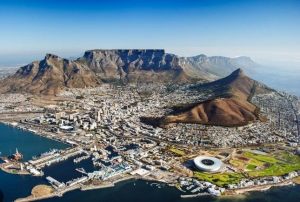 presided over by the Olympus-like grandeur of Table Mountain, there is absolutely no question that Cape Town is one of the world’s most beautiful cities. And, although I’ve visited South Africa’s Mother City on several occasions, its spectacular mountain scenery, relaxed ocean charm, and sense of living history never fail to both arouse awareness and stimulate curiosity.
presided over by the Olympus-like grandeur of Table Mountain, there is absolutely no question that Cape Town is one of the world’s most beautiful cities. And, although I’ve visited South Africa’s Mother City on several occasions, its spectacular mountain scenery, relaxed ocean charm, and sense of living history never fail to both arouse awareness and stimulate curiosity. arranged a full day Cape Town tour through the Guiltedge Travel Group, which we had utilized on previous occasions and had always been more than pleased with the results…
arranged a full day Cape Town tour through the Guiltedge Travel Group, which we had utilized on previous occasions and had always been more than pleased with the results…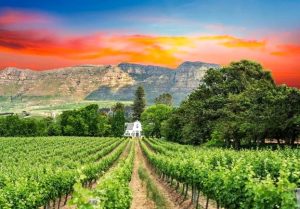 estates, Klein Constantia is situated in the midst of ancient trees and lush greenery in picturesque foothills, offering superb views across the Constantia Valley and False Bay.
estates, Klein Constantia is situated in the midst of ancient trees and lush greenery in picturesque foothills, offering superb views across the Constantia Valley and False Bay.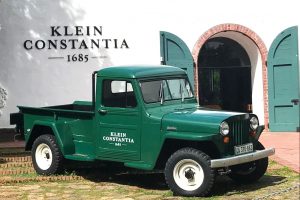 Day. Matthew grew up in Johannesburg; but, because of his interest in winemaking, he relocated to the Cape to pursue an education in this field. After graduating from Stellenbosch University with a bachelor of science degree in viticulture and oenology, his resume included work at various local and international estates, from Meerlust Estate in Stellenbosch to Chateau Belefont-Belcier in St. Emilion, Elderton Estate in the Barossa Valley, and Dancing Hares Estate in the Napa Valley.
Day. Matthew grew up in Johannesburg; but, because of his interest in winemaking, he relocated to the Cape to pursue an education in this field. After graduating from Stellenbosch University with a bachelor of science degree in viticulture and oenology, his resume included work at various local and international estates, from Meerlust Estate in Stellenbosch to Chateau Belefont-Belcier in St. Emilion, Elderton Estate in the Barossa Valley, and Dancing Hares Estate in the Napa Valley.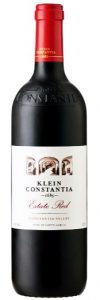 We tasted a number of intriguing wines here, all of which were worthy of consideration. There were, however, several standouts. The Sauvignon Blanc, for example, had its own unique charm. It was bright & light as a feather in the glass, the aromas were scintillatingly subtle, and the palate was… well, yes… brisk & lively with a delightfully citrusy touch. This was, indeed, as the estate noted, “an elevated expression of Sauvignon Blanc.” The Chardonnay was equally up to the mark. Full-bodied and elegantly structured, yet with an enticing backbone of acidity. My favorite of the tasting, however, was the Estate Red. A blend of 69% Cabernet Sauvignon, 28% Malbec, and 3% Petit Verdot, it was deep ruby red in color, bursting with red fruit aromas, and powerful yet elegant on the palate with a long lingering finish.
We tasted a number of intriguing wines here, all of which were worthy of consideration. There were, however, several standouts. The Sauvignon Blanc, for example, had its own unique charm. It was bright & light as a feather in the glass, the aromas were scintillatingly subtle, and the palate was… well, yes… brisk & lively with a delightfully citrusy touch. This was, indeed, as the estate noted, “an elevated expression of Sauvignon Blanc.” The Chardonnay was equally up to the mark. Full-bodied and elegantly structured, yet with an enticing backbone of acidity. My favorite of the tasting, however, was the Estate Red. A blend of 69% Cabernet Sauvignon, 28% Malbec, and 3% Petit Verdot, it was deep ruby red in color, bursting with red fruit aromas, and powerful yet elegant on the palate with a long lingering finish. how iconic…? Vin de Constance was requested by Napoleon Bonaparte on his deathbed, having shunned all other sustenance. It was imported by King Louis XVI and Marie Antoinette; and Queen Victoria drank it every night before bed to help her sleep. Need I say more?!
how iconic…? Vin de Constance was requested by Napoleon Bonaparte on his deathbed, having shunned all other sustenance. It was imported by King Louis XVI and Marie Antoinette; and Queen Victoria drank it every night before bed to help her sleep. Need I say more?!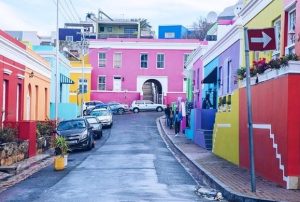 Cape Town’s Bo-Kaap neighborhood is known for its narrow cobblestone streets lined with colorful houses. Its origins date back to the 1760s when numerous huurhuisjes (rental houses) were built and leased to slaves by Dutch colonists. These slaves, who came to be known as Cape Malays, were brought from Malaysia, Indonesia, and various African countries to work in the Cape.
Cape Town’s Bo-Kaap neighborhood is known for its narrow cobblestone streets lined with colorful houses. Its origins date back to the 1760s when numerous huurhuisjes (rental houses) were built and leased to slaves by Dutch colonists. These slaves, who came to be known as Cape Malays, were brought from Malaysia, Indonesia, and various African countries to work in the Cape.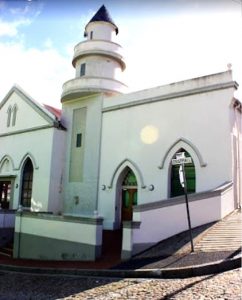 been suggested that the residents here no longer refer to themselves as Cape Malay, but as South African Muslims, as the first established Muslim Mosque in South Africa, the Auwal Mosque (pictured), is also found in Bo-Kaap. And part of the fun of visiting this area of the city is exploring the Islamic kramats (shrines), mosques, food & craft markets, and the fabulous flavors of delectable Cape Malay cookery.
been suggested that the residents here no longer refer to themselves as Cape Malay, but as South African Muslims, as the first established Muslim Mosque in South Africa, the Auwal Mosque (pictured), is also found in Bo-Kaap. And part of the fun of visiting this area of the city is exploring the Islamic kramats (shrines), mosques, food & craft markets, and the fabulous flavors of delectable Cape Malay cookery.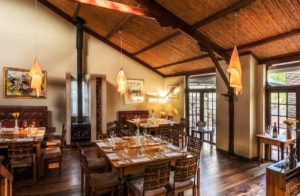 neighborhood, we set out for our lunch reservation at the Aubergine Restaurant. Comfortably ensconced in a transformed 1830s house located in Gardens, one of the oldest parts of the city, reviews consistently rate it among the finest of Cape Town’s fine dining establishments.
neighborhood, we set out for our lunch reservation at the Aubergine Restaurant. Comfortably ensconced in a transformed 1830s house located in Gardens, one of the oldest parts of the city, reviews consistently rate it among the finest of Cape Town’s fine dining establishments. Bresselschmidt has been turning out a mind-boggling, palate-pleasing array of East-meets-West cuisine infused with local ingredients that has kept his loyal clientele oohing and ahhing and has placed him on numerous Top Tens and Readers’ Favorites lists.
Bresselschmidt has been turning out a mind-boggling, palate-pleasing array of East-meets-West cuisine infused with local ingredients that has kept his loyal clientele oohing and ahhing and has placed him on numerous Top Tens and Readers’ Favorites lists.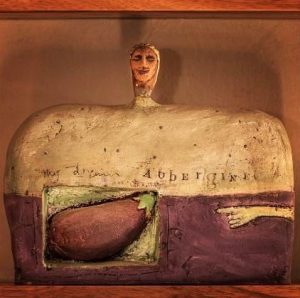 enough dissenting opinions to give one pause. Then couple this with a rather interesting review by Daisy Jones in winemag.co.za: “Despite the plaudits, despite the showcasing of local ingredients, our food was generally ordinary, and in the case of my main course, downright awful.”
enough dissenting opinions to give one pause. Then couple this with a rather interesting review by Daisy Jones in winemag.co.za: “Despite the plaudits, despite the showcasing of local ingredients, our food was generally ordinary, and in the case of my main course, downright awful.”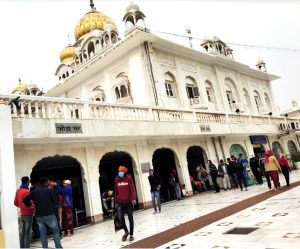 Connaught Place, it is instantly recognizable by its distinctive golden dome.
Connaught Place, it is instantly recognizable by its distinctive golden dome.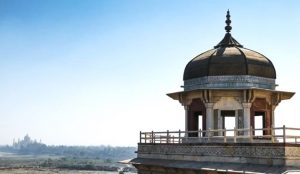 is located 140 miles south-east of Delhi, the national capital. With a population of roughly 1.6 million, Agra is the fourth-most populous city in Uttar Pradesh and the twenty-third most populous city in India.
is located 140 miles south-east of Delhi, the national capital. With a population of roughly 1.6 million, Agra is the fourth-most populous city in Uttar Pradesh and the twenty-third most populous city in India.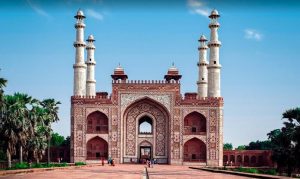 Akbar (pictured: The mausoleum of the third and greatest Mughal emperor Akbar; built in 1605-1613 by his son, Jahangir), and the Taj Mahal, constructed between 1632 and 1648 by Shah Jahan in remembrance of his wife, Mumtaz Mahal.
Akbar (pictured: The mausoleum of the third and greatest Mughal emperor Akbar; built in 1605-1613 by his son, Jahangir), and the Taj Mahal, constructed between 1632 and 1648 by Shah Jahan in remembrance of his wife, Mumtaz Mahal.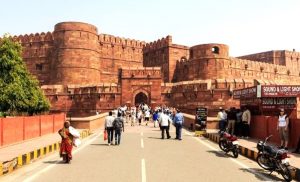 approximately1.5-mile-long red sandstone walls contained the imperial city of the Mughal rulers. Mughal emperor Humayun was crowned here. It was later renovated by the Mughal emperor Akbar from 1565; and the present-day structure was completed in 1573. It served as the main residence of the rulers of the Mughal dynasty until the capital was shifted from Agra to Delhi.
approximately1.5-mile-long red sandstone walls contained the imperial city of the Mughal rulers. Mughal emperor Humayun was crowned here. It was later renovated by the Mughal emperor Akbar from 1565; and the present-day structure was completed in 1573. It served as the main residence of the rulers of the Mughal dynasty until the capital was shifted from Agra to Delhi.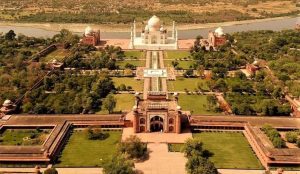 It was commissioned in 1631 by Shah Jahan, the fifth Mughal emperor (r. 1628-1658) to house the tomb of his favorite wife, Mumtaz Mahal, who died on June 17th of that year, giving birth to their 14th child. It also houses the tomb of Shah Jahan himself. The tomb is the centerpiece of a 42-acre complex, which includes a mosque, a guest house, and is set in formal gardens enclosed on three sides by a crenellated wall (a wall containing battlements).
It was commissioned in 1631 by Shah Jahan, the fifth Mughal emperor (r. 1628-1658) to house the tomb of his favorite wife, Mumtaz Mahal, who died on June 17th of that year, giving birth to their 14th child. It also houses the tomb of Shah Jahan himself. The tomb is the centerpiece of a 42-acre complex, which includes a mosque, a guest house, and is set in formal gardens enclosed on three sides by a crenellated wall (a wall containing battlements).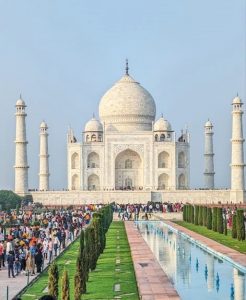 artists and stonecutters were used. The translucent white marble was brought from Makrana, Rajasthan; the jasper from the Punjab region; jade & crystal from China. The turquoise was from Tibet, the lapis lazuli (a deep blue metamorphic rock used as a semi-precious stone) from Afghanistan, the sapphire from Sri Lanka, and the carnelian from Arabia. In all, 28 types of precious and semi-precious stones were inlaid into the white marble.
artists and stonecutters were used. The translucent white marble was brought from Makrana, Rajasthan; the jasper from the Punjab region; jade & crystal from China. The turquoise was from Tibet, the lapis lazuli (a deep blue metamorphic rock used as a semi-precious stone) from Afghanistan, the sapphire from Sri Lanka, and the carnelian from Arabia. In all, 28 types of precious and semi-precious stones were inlaid into the white marble.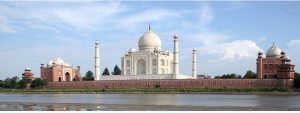 in India and one of the universally admired masterpieces of the world’s heritage.” It is regarded by many as the pinnacle of Mughal architecture. However, due to the global attention that it has received, and the millions of visitors it attracts, the Taj Mahal has become a prominent image that is associated with India… but even more than this, a symbol of India itself, as well as one of the new Seven Wonders of the World (pictured: view of the Taj Mahal and outlying buildings from across the Yamuna River).
in India and one of the universally admired masterpieces of the world’s heritage.” It is regarded by many as the pinnacle of Mughal architecture. However, due to the global attention that it has received, and the millions of visitors it attracts, the Taj Mahal has become a prominent image that is associated with India… but even more than this, a symbol of India itself, as well as one of the new Seven Wonders of the World (pictured: view of the Taj Mahal and outlying buildings from across the Yamuna River).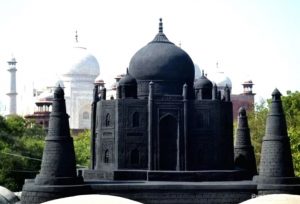 1665. He maintained that Shah Jahan had begun the construction of his own tomb on the opposite side of the river, but that Jahan’s son, Aurangzeb, overthrew him before the Black Taj Mahal could be built. Local legends also add that Shah Jahan intended to connect the two tombs with a bridge across the Yamuna River, possibly made of silver.
1665. He maintained that Shah Jahan had begun the construction of his own tomb on the opposite side of the river, but that Jahan’s son, Aurangzeb, overthrew him before the Black Taj Mahal could be built. Local legends also add that Shah Jahan intended to connect the two tombs with a bridge across the Yamuna River, possibly made of silver.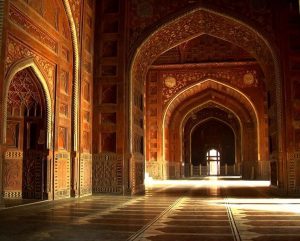 As awe-inspiring as the exterior may be, the interior ornamentation is equally impressive. As you enter, you observe a large octagonal-shaped structure with a dome at the top. The interiors are stunning, amazingly beautiful, yet beguilingly subtle. The basic elements of the structure are Persian. The floor is vast, echoing the slightest sound, while a series of breath-taking arches are embellished with exquisite calligraphy.
As awe-inspiring as the exterior may be, the interior ornamentation is equally impressive. As you enter, you observe a large octagonal-shaped structure with a dome at the top. The interiors are stunning, amazingly beautiful, yet beguilingly subtle. The basic elements of the structure are Persian. The floor is vast, echoing the slightest sound, while a series of breath-taking arches are embellished with exquisite calligraphy.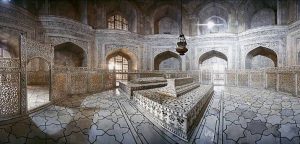 eight arches, four on the lower portion of the walls, four on the upper. The four top arches form balconies – viewing areas – each containing a jali or screening carved from marble in the shape of vines, fruits, and flowers.
eight arches, four on the lower portion of the walls, four on the upper. The four top arches form balconies – viewing areas – each containing a jali or screening carved from marble in the shape of vines, fruits, and flowers.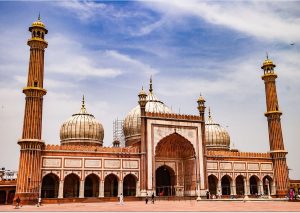 between 1650 and 1656, it was constructed by approximately 5,000 workers. The workforce was diverse, consisting of Indians, Arabs, Persians, Turks, and Europeans. The project was supervised by Sadullah Khan, the wazir (prime minister) during Shah Jahan’s reign, and Fazil Khan, the comptroller of Shah Jahan’s household. The cost of the construction at the time was one million rupees. The mosque was inaugurated on July 23, 1656, by Syed Abdul Ghafoor Shah Bukhari from Bukhara, Uzbekistan, who had been invited by Shah Jahan to be the Shahi Imam (Royal Imam) of the mosque. The Jama Masjid was one of the last monuments built under Shah Jahan. After it’s completion, it served as the royal mosque of the emperors until the end of the Mughal period.
between 1650 and 1656, it was constructed by approximately 5,000 workers. The workforce was diverse, consisting of Indians, Arabs, Persians, Turks, and Europeans. The project was supervised by Sadullah Khan, the wazir (prime minister) during Shah Jahan’s reign, and Fazil Khan, the comptroller of Shah Jahan’s household. The cost of the construction at the time was one million rupees. The mosque was inaugurated on July 23, 1656, by Syed Abdul Ghafoor Shah Bukhari from Bukhara, Uzbekistan, who had been invited by Shah Jahan to be the Shahi Imam (Royal Imam) of the mosque. The Jama Masjid was one of the last monuments built under Shah Jahan. After it’s completion, it served as the royal mosque of the emperors until the end of the Mughal period.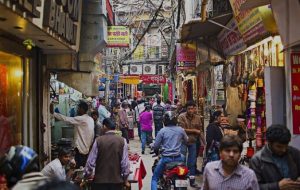 This is what is commonly called the Chandni ‘Chowk, historic buildings that were once home to prominent families of days-gone-by. Today, however, this district is one of the country’s best-known wholesale markets for textiles, electronic goods, and watches. Its narrow, winding side streets are also home to shops overflowing with spices, jewelry, books, hardware, brilliantly-dyed fabrics, and vendors hawking a variety of foods prepared on the spot… Awash with tsunamis of bustling humanity, the crowded streets conjured up nightmarish visions described in the oft-quoted opening sentences of American biologist Paul Ehrlich’s The Population Bomb (see photograph).
This is what is commonly called the Chandni ‘Chowk, historic buildings that were once home to prominent families of days-gone-by. Today, however, this district is one of the country’s best-known wholesale markets for textiles, electronic goods, and watches. Its narrow, winding side streets are also home to shops overflowing with spices, jewelry, books, hardware, brilliantly-dyed fabrics, and vendors hawking a variety of foods prepared on the spot… Awash with tsunamis of bustling humanity, the crowded streets conjured up nightmarish visions described in the oft-quoted opening sentences of American biologist Paul Ehrlich’s The Population Bomb (see photograph). different in nature: a hair-raising dune ride through a portion of the Al Sahara Desert.
different in nature: a hair-raising dune ride through a portion of the Al Sahara Desert.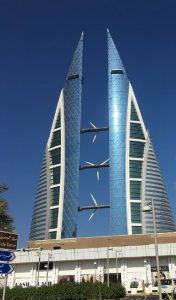 incredible World Trade Center, a 787 ft, 50-floor twin tower complex that houses both a five-star hotel and a luxury shopping mall, among its other intriguing attributes.
incredible World Trade Center, a 787 ft, 50-floor twin tower complex that houses both a five-star hotel and a luxury shopping mall, among its other intriguing attributes.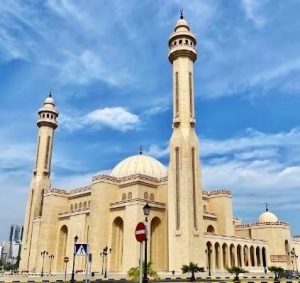 largest mosques in the world, having the capacity to accommodate over 7,000 worshippers at a time. The mosque was built by the late Sheikh Isa Bin Salman Al Khalifa in1987 and was named after Ahmed Al Fateh. In 2006, Al-Fateh became the site of the National Library of Bahrain.
largest mosques in the world, having the capacity to accommodate over 7,000 worshippers at a time. The mosque was built by the late Sheikh Isa Bin Salman Al Khalifa in1987 and was named after Ahmed Al Fateh. In 2006, Al-Fateh became the site of the National Library of Bahrain.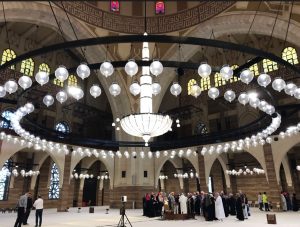 Austria. The doors were made of teak wood from India. Throughout the mosque is Kufic calligraphy.
Austria. The doors were made of teak wood from India. Throughout the mosque is Kufic calligraphy.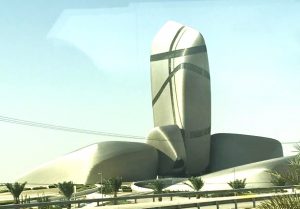 extremis. Whether observed from a distance, or up close and personal, the structure is equally mind-boggling. The building covers some 80,000 square meters, its intriguing shape inspired by the internal structural shape of oil-bearing rock formations. The Norwegian architectural firm Snohetta designed the building and Buro Happold, a UK professional services firm, was in charge of the engineering design. It was built and is operated by Saudi Aramco, and was inaugurated by King Salman bin Abdulaziz on December 1, 2016. The Center is located where the first commercial Saudi oilfield was discovered in March 1938.
extremis. Whether observed from a distance, or up close and personal, the structure is equally mind-boggling. The building covers some 80,000 square meters, its intriguing shape inspired by the internal structural shape of oil-bearing rock formations. The Norwegian architectural firm Snohetta designed the building and Buro Happold, a UK professional services firm, was in charge of the engineering design. It was built and is operated by Saudi Aramco, and was inaugurated by King Salman bin Abdulaziz on December 1, 2016. The Center is located where the first commercial Saudi oilfield was discovered in March 1938.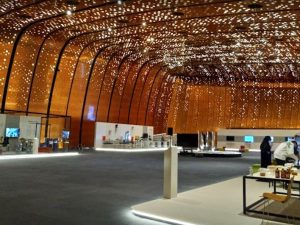 The Center’s Great Hall (pictured) is the dedicated area for short-term exhibitions. It has hosted an exhibition of original paintings by Norwegian Expressionist artist Edvard Munch, as well as an exhibition of manuscripts by Leonardo da Vinci.
The Center’s Great Hall (pictured) is the dedicated area for short-term exhibitions. It has hosted an exhibition of original paintings by Norwegian Expressionist artist Edvard Munch, as well as an exhibition of manuscripts by Leonardo da Vinci.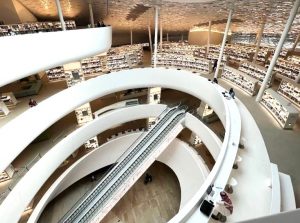 displays a mix of movies, including popular international features, documentaries, and independent productions. The Ithra Library (pictured) is one of the largest and modern in the region. It is designed to host about 500,000 texts, as well as a variety of digital resources, and also hosts workshops, lectures, and book clubs. In addition to performances, the Ithra Theater also organizes events intended to develop theater in Saudi Arabia, displays local & international plays, and offers theatrical training workshops. The Energy Exhibit offers visitors an ever-popular introduction to the oil industry, including renewables, ecology, and technology.
displays a mix of movies, including popular international features, documentaries, and independent productions. The Ithra Library (pictured) is one of the largest and modern in the region. It is designed to host about 500,000 texts, as well as a variety of digital resources, and also hosts workshops, lectures, and book clubs. In addition to performances, the Ithra Theater also organizes events intended to develop theater in Saudi Arabia, displays local & international plays, and offers theatrical training workshops. The Energy Exhibit offers visitors an ever-popular introduction to the oil industry, including renewables, ecology, and technology.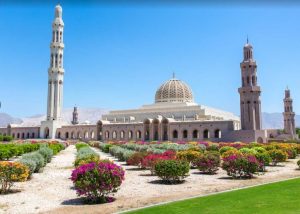 The grand mosque was inaugurated by the Sultan himself on May 4, 2001, as a gift to the nation to celebrate his third decade in power. His policies found favor with many, as his enlightened leadership spearheaded Oman toward becoming a modern state while still preserving age-old traditions of the Islamic way of life.
The grand mosque was inaugurated by the Sultan himself on May 4, 2001, as a gift to the nation to celebrate his third decade in power. His policies found favor with many, as his enlightened leadership spearheaded Oman toward becoming a modern state while still preserving age-old traditions of the Islamic way of life.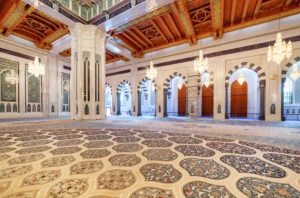 crystals, contains 1,122 halogen bulbs, and also includes a dimming system and a staircase for maintenance within the chandelier. Thirty-four smaller chandeliers of the same design are hung in other parts of the building.
crystals, contains 1,122 halogen bulbs, and also includes a dimming system and a staircase for maintenance within the chandelier. Thirty-four smaller chandeliers of the same design are hung in other parts of the building. The double-story library is a striking cultural representative of Oman’s contemporary renaissance inspired by the late Sultan. It contains more than 23,342 books on the topics of Islamic culture, natural science, fine arts, philosophy, and psychology within its six departments, including a children’s section. The collection of predominantly Arabic and English titles grows larger each year.
The double-story library is a striking cultural representative of Oman’s contemporary renaissance inspired by the late Sultan. It contains more than 23,342 books on the topics of Islamic culture, natural science, fine arts, philosophy, and psychology within its six departments, including a children’s section. The collection of predominantly Arabic and English titles grows larger each year. century, the city has gone from being a sandy desert to becoming one of the top five cities in the world with the most buildings over 100 meters (328 feet) tall is absolutely awe-inspiring. In 2008 alone, forty-one of these incredible skyscrapers rose from the ground.
century, the city has gone from being a sandy desert to becoming one of the top five cities in the world with the most buildings over 100 meters (328 feet) tall is absolutely awe-inspiring. In 2008 alone, forty-one of these incredible skyscrapers rose from the ground. definitely worth a visit in its own right.
definitely worth a visit in its own right. marine species and other species dependent on them for food.
marine species and other species dependent on them for food. trainer – was both charming and informative. She gave us a quick glimpse of horses in general, their different breeds – polo ponies, thoroughbreds, Arabian – and their specialties and needs, as well as the equipment utilized. She guided us through the Club House, polo pitches, equestrian training facilities, and the stable, where we had opportunity to get up close & personal with the horses.
trainer – was both charming and informative. She gave us a quick glimpse of horses in general, their different breeds – polo ponies, thoroughbreds, Arabian – and their specialties and needs, as well as the equipment utilized. She guided us through the Club House, polo pitches, equestrian training facilities, and the stable, where we had opportunity to get up close & personal with the horses. have the opportunity to see a live belly-dancing show, a spectacular fire show, and various other entertainment that is traditional in Dubai and the surrounding region. Sit back and relax, watching the sun set softly over the desert horizon, and reflect on a day well spent.”
have the opportunity to see a live belly-dancing show, a spectacular fire show, and various other entertainment that is traditional in Dubai and the surrounding region. Sit back and relax, watching the sun set softly over the desert horizon, and reflect on a day well spent.” chandeliers, and the world’s largest hand-knotted carpet. The main prayer hall is dominated by one of the world’s largest chandeliers. The late Sheikh Zayed bin Sultan Al Nahyan built this mosque to convey historic consequence and to embody the Islamic message of peace, tolerance, and diversity. He intended that the Grand Mosque be a living reference of modern Islamic architecture that links the past with the present and creates a place of Islamic science and learning that would reflect genuine Islamic values. Constructed at a cost of 1.4 billion dollars, it is capable of accommodating 141,000 worshippers.
chandeliers, and the world’s largest hand-knotted carpet. The main prayer hall is dominated by one of the world’s largest chandeliers. The late Sheikh Zayed bin Sultan Al Nahyan built this mosque to convey historic consequence and to embody the Islamic message of peace, tolerance, and diversity. He intended that the Grand Mosque be a living reference of modern Islamic architecture that links the past with the present and creates a place of Islamic science and learning that would reflect genuine Islamic values. Constructed at a cost of 1.4 billion dollars, it is capable of accommodating 141,000 worshippers. a total height of 2,722 feet, or just over half a mile, it has been the tallest structure and building in the world since 2009, supplanting Taipei 101, the previous holder of the status.
a total height of 2,722 feet, or just over half a mile, it has been the tallest structure and building in the world since 2009, supplanting Taipei 101, the previous holder of the status. hotels, 7.4 acres of parkland, 19 skyscrapers, the Dubai Mall, and the 30-acre artificial Burj Khalifa Lake.
hotels, 7.4 acres of parkland, 19 skyscrapers, the Dubai Mall, and the 30-acre artificial Burj Khalifa Lake. began to pop up.
began to pop up. above), there was a speaker situated almost directly above our heads; and, as the evening wore on, the piped-in music became louder and louder. Carrying on a reasonably intelligent conversation became completely impossible.
above), there was a speaker situated almost directly above our heads; and, as the evening wore on, the piped-in music became louder and louder. Carrying on a reasonably intelligent conversation became completely impossible.